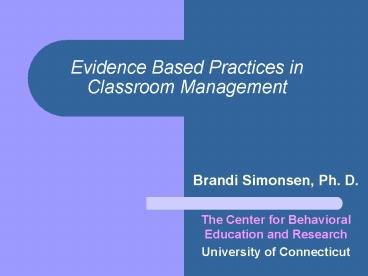Evidence Based Practices in Classroom Management PowerPoint PPT Presentation
1 / 16
Title: Evidence Based Practices in Classroom Management
1
Evidence Based Practices in Classroom Management
- Brandi Simonsen, Ph. D.
- The Center for Behavioral Education and Research
- University of Connecticut
2
Special Thanks
- Work of many researchers who preceded us!
- Collaborative efforts of
- Brandi Simonsen,
- Sarah Fairbanks,
- Amy Briesch,
- Diane Myers,
- George Sugai
- Members of the NEW
- Center for Behavioral Education and Research
(CBER) - in the Neag School of Education at UConn.
3
What kind of students can display problematic
behavior?
All students. Students with/without labels who
are served in general/special education can
display problematic behavior. This is not a
special education issue. It is an education
issue.
We need to learn more about the 5 critical
features of effective classroom management to
be able to help all students.
4
School-wide Positive Behavior Support Systems
Classroom Setting Systems
Non-classroom Setting Systems
Individual Student Systems
School-wide Systems
5
Evidence Based Practices in Classroom Management
- Maximize structure in your classroom.
- Post, teach, review, monitor, and reinforce a
small number of positively stated expectations. - Actively engage students in observable ways.
- Establish a continuum of strategies to
acknowledge appropriate behavior. - Establish a continuum of strategies to respond to
inappropriate behavior.
(Simonsen, Fairbanks, Briesch, Myers, Sugai,
accepted)
6
1. Maximize structure in your classroom.
- Develop Predictable Routines
- Teacher routines volunteers, communications,
movement, planning, grading, etc. - Student routines personal needs, transitions,
working in groups, independent work, instruction,
getting, materials, homework, etc. - Design environment to (a) elicit appropriate
behavior and (b) minimize crowding and
distraction - Arrange furniture to allow easy traffic flow.
- Ensure adequate supervision of all areas.
- Designate staff student areas.
- Seating arrangements (groups, carpet, etc.)
7
2. Post, Teach, Review, Monitor, and
reinforce a small number of positively stated
expectations.
- Establish
- Teach
- Prompt
- Monitor
- Evaluate
8
Establish Behavioral Expectations/Rules
Teach Rules in the Context of Routines
A closer look...
Prompt or Remind Students of Expected behavior
Monitor Student's Behavior in the Natural Context
9
Establish Procedures for Encouraging Rule
Following
Establish Procedures for Responding to Rule
Violations
Evaluate the effect of instruction
These are things you should do in any school
environment!!!
10
3. Actively engage students in observable ways.
- Provide high rates of opportunities to respond
- Vary individual v. group responding
- Increase participatory instruction (enthusiasm,
laughter) - Consider various observable ways to engage
students - Written responses
- Writing on individual white boards
- Choral responding
- Gestures
- Other ____________
- Link engagement with outcome objectives (set
goals to increase engagement and assess student
change CARs verbal/written)
11
3. Range of evidence based practices that
promote active engagement
- Direct Instruction
- Computer Assisted Instruction
- Class-wide Peer Tutoring
- Guided notes
- Response Cards
12
4. Establish a continuum of strategies to
acknowledge appropriate behavior.
- Specific and Contingent Praise
- Group Contingencies
- Behavior Contracts
- Token Economies
13
5. Establish a continuum of strategies to
respond to inappropriate behavior.
- Error Corrections
- Differential Reinforcement
- Planned ignoring
- Response Cost
- Time out from reinforcement
14
RECAP Evidence Based Practices in Classroom
Management
- Maximize structure in your classroom.
- Post, teach, review, monitor, and reinforce a
small number of positively stated expectations. - Actively engage students in observable ways.
- Establish a continuum of strategies to
acknowledge appropriate behavior. - Establish a continuum of strategies to respond to
inappropriate behavior.
(Simonsen, Fairbanks, Briesch, Myers, Sugai,
accepted)
15
7r
Positive Behavior Support Classroom
Management Self-Assessment Revised Brandi
Simonsen, Sarah Fairbanks, Amy Briesch, George
Sugai Center on Positive Behavioral
Interventions and Supports University of
Connecticut Version May 15, 2006
16
RESOURCES
- Classroom Management Self Assessment
- Contact info
- brandi.simonsen_at_uconn.edu
- Web info
- http//www.education.uconn.edu/
- www.cber.org
- www.pbis.org

